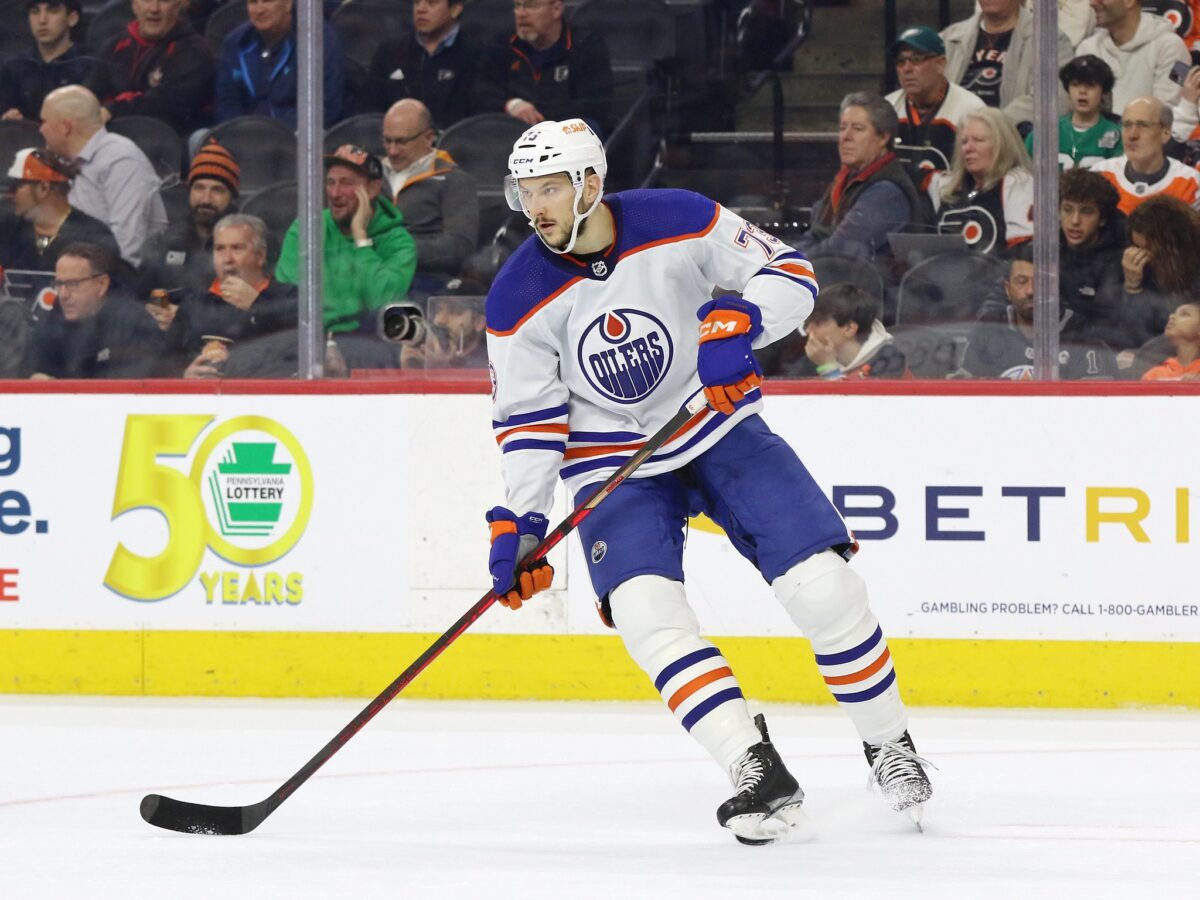The Edmonton Oilers quickly learned that they’re dealing with a whole different beast in the second round with the Vegas Golden Knights, in comparison to the more passive and defensive-minded Los Angeles Kings from the first round. The Golden Knights were hard on the forecheck in Game 1 and played a quick transition game that was simply too much to handle for the Oilers, losing by a score of 6-4.
Edmonton will need a better effort from up and down their lineup if they hope to come out on top against Vegas. In the first round, Leon Draisaitl and Connor McDavid led the way in point production as expected, but they also had contributions from depth players like Klim Kostin and Nick Bjugstad, who stepped up to score timely goals. Now, they’re facing a new challenge in the second round with a Vegas team that plays high-tempo hockey and therefore needs more players to step up. That said, there are two players in particular who had impactful regular seasons but have failed to play at their best in the postseason so far, and that’s Ryan Nugent-Hopkins and Vincent Desharnais.
Moving forward, two questions come to mind — when can we expect Nugent-Hopkins, who scored 104 points in the regular season, to make an impact in the playoffs? And what should the Oilers do with Desharnais, who has looked a step behind in postseason play?
Nugent-Hopkins Needs to Get to the Tough Areas to Score Goals
Nugent-Hopkins had a regular season to remember when he recorded a career-high 104 points. In addition, he was an essential component to the NHL’s best-ever power play unit, and he delivered solid two-way play at 5-on-5. Yet, through seven playoff games, despite having four assists, he hasn’t scored and has only managed to record a single point at even strength. Moreover, he’s giving up more high-danger chances than he’s creating, with the high-danger chances at 20-25 (44.44%) in favour of the opposition at even strength in the postseason.

Related: 3 Takeaways From Oilers’ Game 1 Loss to the Golden Knights
Yet, we’ve seen him elevate his play in the playoffs before, such as last season when he tallied six goals and eight assists in 16 games. To add to that, he even delivered his first “signature Stanley Cup playoffs” moment when he scored the game-winning goal against the Calgary Flames in the second round in Game 4. However, so far this postseason, Nugent-Hopkins has failed to rise to the intensity of playoff hockey.
Despite an ordinary first round against the Kings, Nugent-Hopkins had a chance to turn the corner in the first game against the Golden Knights, but much like the rest of his team in the 6-4 loss, he struggled to find momentum. In Game 1 against Vegas, he didn’t have a shot on net, was minus-1 and the shots were 7-4 in favour of his opponents at 5-on-5 when he was on the ice. Additionally, in the third period, he lost an edge and couldn’t get in the lane to block a shot, enabling Vegas to score their fourth goal.
The Oilers’ superstar duo of McDavid and Draisaitl, who’s establishing himself as one of the NHL’s all-time playoff greats, are doing what they can to keep their team in their fight, but at some point, they need their fellow 100-plus point player, Nugent-Hopkins to step up and start scoring goals. Although, it’s easy to say “start scoring”, but one way he can inch closer to doing so is by battling harder to get to the middle of the ice, to have an opportunity to unleash his lethal shot in prime scoring areas.
The 6-Foot-6 Desharnais Looks a Step Behind This Postseason
Desharnais emerged as one of the team’s feel-good stories of the regular season. He became a rarity being a seventh-round pick to play in the NHL, but not only that, he was fierce in front of the net, and effective on the penalty kill, ultimately carving a role on the back end on the third pairing. That said, the 6-foot-6 defender looks a step behind in the faster-paced postseason. In 36 regular season games, he had a plus-15 rating; but, in seven games played so far in the playoffs, he’s minus-5. However, it’s worth noting that he was penalized in the first round against the Kings for being overly aggressive, which was a big component of what made him highly effective in the regular season, and he could be second-guessing his decisions on the ice now.

He struggled to keep up in the opening round against the Kings, but it was most apparent in Game 4 when he was the culprit on three goals against in the first period alone. Most notably, he couldn’t match Kings’ forward Kevin Fiala’s speed, which led to the first goal of the game in the opening frame, and later in the period Viktor Arvidsson spun around him easily for a break to the net, beating Stuart Skinner. Less than two minutes later, he got out hustled to a scrambled puck in front of his net, missed on a clearing attempt and the Kings’ Anze Kopitar walked in and beat Skinner again. Head coach Jay Woodcroft played him minimally the rest of Game 4 but gave the blueliner the benefit of the doubt to play through the struggles and deployed him an average of 13:75 in the remaining two games of the series.
Yet, his difficulties continued in Game 1 of the second round, where he once again made a mistake on the first goal of the game when he turned the puck over on a failed clearing attempt. He made additional mistakes overall on the night that led to Vegas goals, finishing with a minus-2 rating in the Game 1 defeat.
What Should the Oilers Do With Desharnais Moving Forward?
So, what should Edmonton do with the struggling blueliner? As we saw in Game 1 against the Golden Knights, Oilers’ defenceman Philip Broberg played 9:19, which was three more minutes than Desharnais and this could be a sign of things to come for the rest of the series. Although both are fairly inexperienced in NHL playoff hockey, Broberg is the more mobile defender and stands a better chance to get to pucks quicker against a fast-paced Golden Knights’ forecheck.
That said, the Oilers like using Desharnais on the penalty kill, so if the team decides to go the 11 forwards and seven defencemen route the rest of the series, his ice time should be reduced at 5-on-5 while playing the majority of his minutes shorthanded. However, even that deserves more careful consideration, because an interesting stat, as mentioned by Oilers’ colour commentator Bob Stauffer on the “Oilers Now” show, is that on the penalty kill with Desharnais on the ice, the Oilers have a .667 save percentage (SV%), and while he’s not on the ice shorthanded, it improves to .810 SV%.
Nonetheless, if he continues to play regular minutes, he needs to do less on the ice, and opt for the simple “off the boards and out” play against a feisty Golden Knights’ forecheck. Yet, another viable option, is that if Edmonton goes the traditional 12 forwards and six defencemen format, they sit Desharnais in the press box, while Broberg plays on the third pairing with Brett Kulak.
Overall, Desharnais is still a rookie defenceman who’s overcome adversity throughout his career and can most definitely bounce back from his struggles. If it’s too late for him to make an impact in the series against the Golden Knights, if he can work on his footspeed in the future, this experience in the postseason will be a valuable lesson for him, which will make him an even better player in the long run.
What should the Oilers do with Vincent Desharnais for the rest of the series against the Golden Knights? Have your say in the comments below!